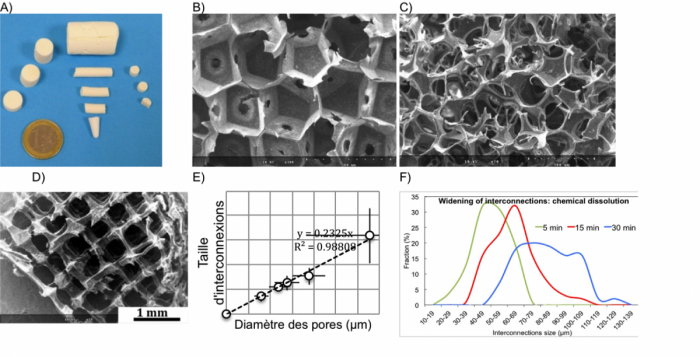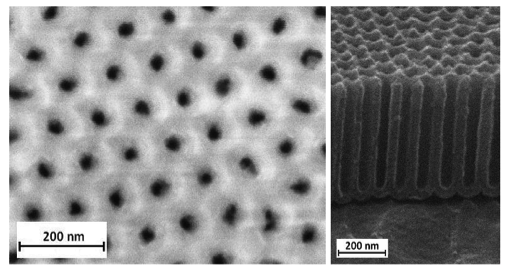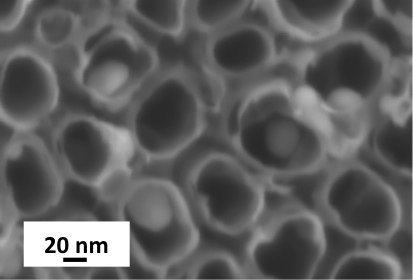Chemical physics of biomaterials and nanostructures
Biomaterials
Goals of this action are interdisciplinary in fields of physics, chemistry and biology:
(1) To characterise at the nanometer scale, by nano- ion beams, biomimetism and bioactivity processes (formation and growth of biological apatites) at interfaces between bioceramics and living tissues;
(2) To define experimental strategies to obtain chemical maps at the nanometer scale & local quantitative measurements ; detection of relevant bone trace elements in bioceramics and in bone
(3) To develop by soft chemistry nanostructured bioactive glasses used as bone substitutes or as scaffolds for tissue engineering;
(4) To study the influence of porosity and composition (doping in trace elements or in proteins) of these materials on their bioactive properties and on cellular reactions;
(5) To study by nano-ion beams the distribution of proteins in bioceramics and the behavior of bone cells in contact with bioceramics.(1) To characterise at the nanometer scale, by nano- ion beams, biomimetism and bioactivity processes (formation and growth of biological apatites) at interfaces between bioceramics and living tissues;
(2) To define experimental strategies to obtain chemical maps at the nanometer scale & local quantitative measurements ; detection of relevant bone trace elements in bioceramics and in bone
(3) To develop by soft chemistry nanostructured bioactive glasses used as bone substitutes or as scaffolds for tissue engineering;
(4) To study the influence of porosity and composition (doping in trace elements or in proteins) of these materials on their bioactive properties and on cellular reactions;
(5) To study by nano-ion beams the distribution of proteins in bioceramics and the behavior of bone cells in contact with bioceramics.(1) To characterise at the nanometer scale, by nano- ion beams, biomimetism and bioactivity processes (formation and growth of biological apatites) at interfaces between bioceramics and living tissues;
Innovations for bone tissue engineering: development, optimization and validation of new bioactive hybrid matrices

The evolution of life expectancy generates a gradual transformation of the population. This increase in longevity is accompanied by a deterioration in the general health of seniors and an upsurge in chronic diseases. There is a dichotomy of life expectancy and life expectancy without disability. Among the manifestations of senescence, the impairment of the musculoskeletal system is particularly disabling and accelerates considerably the entry into dependence. This is also the case for the youngest in traumatic or pathological cases because the autonomy and mobility of the person are engaged. Thus, globally 2.2 million bone grafts are performed each year, but the complication rate remains high and is estimated at 30%.
These facts outlines a major societal challenge; materials of animal origin cause problems of histocompatibility, pathogenicity and therefore rejection. This is why research efforts primarily target the development of synthetic biomaterials that promote bone regeneration. We are talking about bioactive implants that stimulate and actively participate in the regeneration of tissues. At the same time, cell therapies aim to use stem cells to increase bone remodeling. By combining the two approaches, bone tissue engineering intends to use the solutions proposed by both materials engineering and life sciences for the reconstruction of true tissue grafts. This theme in real emergence has a strong societal and innovation potential; to mature, it requires a strong interweaving of multidisciplinary skills and decompartmentalization of knowledge. It is one of the objectives of this project to contribute to the development of bone tissue engineering through multidisciplinary collaboration between the LPC and INRA partners.
The Biomaterials team has recently patented an innovative process that allows the synthesis of organic-inorganic hybrid matrices based on bioactive glass and biocompatible polymer with varied physicochemical characteristics but whose osteogenic potential requires to be validated. To our advantage, many key parameters of hybrid matrices can be modulated such as composition, organic-inorganic interactions, internal porosity of implants, mechanical strength, resorption in biological media. But to be a successful bone substitute, the matrices must, in addition to their structural mimicry with the bone tissue, be biocompatible and exert an attractive power on the bone cells so that they recognize them as a biological element, colonize them, s' adapt and begin remodeling sequences to transform them into true neo-formed bone tissue.
A first objective of the project is to understand and evaluate the influence of the physicochemical characteristics of the matrices on the behavior of the bone cells, thanks to a close collaborative and interdisciplinary work with the INRA of Theix which will be in charge of the cellular studies, the definition of parameters of biological importance for hybrid matrices, and their evaluation in terms of osteogenic potential. A second objective will be to exploit the possibilities offered by the organomineral doping of hybrid matrices to stimulate bone cell activity, promote tissue formation and thus further enhance the osteogenic power of matrices. A third objective of the project concerns the preclinical validation of the elaborate matrices, as well as a complete characterization of interactions at the tissue / substitute interface.
The ultimate goal of the project is to formulate hybrid matrices with properties optimized for bone tissue engineering, the first step towards the development of high-performance analogs to autologous bone.
Nanostructured surfaces
The research activities area deal with materials science for the development of technological applications involving nanostructured surfaces. The group has two areas of research:
- The fabrication and characterization of nanostructured surfaces and nanoparticles
- The modeling of the wettability of nanostructured surfaces.
The fabrication of nanostructured surfaces of titanium oxide or alumina is obtained on different types of metal substrates by electrochemical methods involving anodizing and electro-depositing processes. The synergetic combination of these different methods and their modularity make it possible to obtain a wide variety of nanoreliefs from metal oxide nanotube layers, nanopillars to nanostructured polymers. These nanostructured surfaces allow studies of wettability by contact angles and their modeling.

Our research in the field of nanostructured surfaces is part of the development of new detection methods. Thus we develop electrodes consisting of nanostructured surfaces associated with the presence of nanoparticles of noble metals for the implementation of future miniaturized detectors. Nanostructured surfaces in the form of nanotube layers are used as host matrices for nanoparticles. The objectives of this research are firstly the development and characterization of nanoparticles of noble metals (gold, silver) in suspension to keep the nanometric properties of the latter. The syntheses of the nanoparticles developed in the laboratory deal with soft chemistry processes mainly using the reduction of metal salts in solution, in a context of development of eco-conceptual method. In a second step, it is a question of ensuring an effective association of the nanoparticles with the nanoporous surface of the host electrode, by strategies of electro deposition of nanoparticles or by dip-coating route. The development of these nanosensors opens the way to many applications in the field of detection through the use of nanostructured electrodes associated with the presence of nanoparticles.

Contact persons
BIOMATERIALS:
Edouard JALLOT, Pr
Edouard.Jallot@clermont.in2p3.fr
Jonathan LAO, associate professor
Jonathan.Lao@clermont.in2p3.fr
NANOSTRUCTURED SURFACES:
Oscar AWITOR, Pr
komla.awitor@uca.fr
Jonathan LAO, associate professor
Jonathan.Lao@clermont.in2p3.fr
NANOSTRUCTURED SURFACES:
Oscar AWITOR, Pr
komla.awitor@uca.fr

